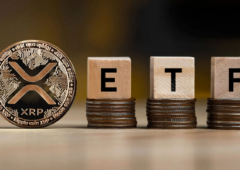Bitcoin Faces Volatility Risk as Asian Holidays and U.S. Shutdown Collide
01.10.2025 15:00 2 min. read Kosta Gushterov
The world’s largest cryptocurrency enters October under unusual pressure, with analysts at K33 Research warning that seasonal trading lulls in Asia, combined with disruptions from the U.S. government shutdown, could unsettle Bitcoin’s price action in the coming days.
Golden Week Historically Brings Flat Performance
China’s Golden Week holiday, which began October 1 and runs through October 7, coincides with South Korean market closures from October 3–9, as well as other Asian breaks. This lull in regional participation has historically dragged on Bitcoin performance, with K33 data showing that the first week of October typically delivers flat or negative returns.
“BTC typically behaves flat during the early October Asian holiday season,” wrote Vetle Lunde, Head of Research at K33, noting that volatility often compresses toward local lows. The 2021 rally, however, was a rare exception, bucking the seasonal pattern with outsized gains.
Lunde also pointed out that this isn’t just about holidays: August through mid-October tends to be one of Bitcoin’s weakest stretches of the year in terms of directional momentum.
Shutdown Adds Fuel to Uncertainty
This year, the macro environment adds further complexity. On Wednesday, the U.S. government entered a partial shutdown after lawmakers failed to pass a funding bill. The move halts non-essential services, furloughs federal workers, and delays critical economic data releases such as jobs reports and inflation numbers.
According to K33, the lack of timely U.S. macro data may thin order books further, exposing traders to sudden swings. “Erratic price action” is particularly likely during overlapping sessions in the first half of October, Lunde warned.
Asia’s Consistent Underperformance
K33’s research highlighted that Asia has been a persistent drag on Bitcoin returns. Year-to-date, compounded returns during Asian trading hours are –9.7%, with the region underperforming both Europe and the U.S. every year since 2021, except for a brief outperformance in 2022.
Much of Bitcoin’s upside momentum has instead emerged during U.S. trading hours, particularly after the launch of spot ETFs. “Profit-taking and mean reversions in Asian hours amid lower relative liquidity may explain the Asian session’s clear underperformance,” Lunde explained.
Outlook for October
As Bitcoin navigates a quiet Asian backdrop and delayed U.S. economic signals, the early weeks of October could set the tone for Q4 trading. With order books thinner than usual, even modest inflows or outflows may produce outsized volatility — leaving traders to watch whether this October resembles the flat lulls of prior years or breaks the pattern, as it did in 2021.
-
1
Bitcoin’s Pullback Seen as Pause Before Potential Rally Toward $160,000
07.10.2025 10:00 2 min. read -
2
Bitcoin Surges to $117K as US Government Shutdown Boosts Safe-Haven Demand
01.10.2025 19:00 3 min. read -
3
Bitcoin and Ethereum ETFs See Over $1.2 Billion in Inflows as Institutions Accelerate Buying
04.10.2025 18:00 2 min. read -
4
Bitcoin: Here is Why the Price Is Down Today
08.10.2025 9:29 2 min. read -
5
First Bitcoin Treasury Merger Raises Questions About How To Value DATs
28.09.2025 13:00 1 min. read
Bitcoin Miners Raise Billions to Bet on AI and HPC Expansion
Public cryptocurrency mining companies are ramping up fundraising through convertible bonds, marking the largest wave of capital raising in the sector since 2021.
Billions Lost, Fear Rising: The Crypto Sell-Off Nobody Saw Coming
The mood across the crypto market turned bleak this week as investors rushed to exit positions, wiping out roughly $230 billion in value within a single day.
Crypto Panic Alert: Altcoins Hit Double-Digit Losses in 24 Hours
The cryptocurrency market is experiencing a significant downturn, with the total market capitalization dropping to $3.57 trillion, down 5.12% in the past 24 hours.
JPMorgan Exposes the Hidden Drivers of the Historic Crypto Selloff
JPMorgan analysts say the sharp crypto downturn last week, marked by massive liquidations, was mainly fueled by crypto-native investors rather than traditional retail or institutional ETF holders.
-
1
Bitcoin’s Pullback Seen as Pause Before Potential Rally Toward $160,000
07.10.2025 10:00 2 min. read -
2
Bitcoin Surges to $117K as US Government Shutdown Boosts Safe-Haven Demand
01.10.2025 19:00 3 min. read -
3
Bitcoin and Ethereum ETFs See Over $1.2 Billion in Inflows as Institutions Accelerate Buying
04.10.2025 18:00 2 min. read -
4
Bitcoin: Here is Why the Price Is Down Today
08.10.2025 9:29 2 min. read -
5
First Bitcoin Treasury Merger Raises Questions About How To Value DATs
28.09.2025 13:00 1 min. read
Bitcoin’s price recently made a significant surge to around $73,000, almost hitting the previous all-time high (ATH), registered back in March.
The cryptocurrency market has experienced a sharp decline, with major tokens and the overall market capitalization taking a hit over the past 24 hours.
Bitcoin (BTC), like most of the cryptocurrency market, saw a price correction today.
After a great start to december, the cryptocurrency market is starting to cool-off as we are witnessing major liquidations across the board.
The Bitcoin Fear & Greed Index has plummeted to "extreme fear," scoring 25 out of 100.
The cryptocurrency market dropped significantly on Sunday, with investors selling risky assets.
World Liberty Financial (WLFI), a decentralized finance platform positioning itself as a response to growing distrust in traditional systems, may soon find validation in the changing landscape of international trade.
Fold Inc., known for its Bitcoin rewards program, is reportedly on the brink of a major business move that could significantly impact its future and the broader cryptocurrency industry.
Analysts at Bernstein have reiterated their $200,000 Bitcoin price forecast for the end of 2025, describing it as “conservative.”
In a recent update, Michaël van de Poppe, a well-known crypto analyst, shared his optimistic outlook for Bitcoin's performance in the latter half of 2024.
Anthony Scaramucci, SkyBridge Capital's founder, expressed optimism about Bitcoin's future, predicting significant new highs within six months.
Even with fresh conflict in the Middle East and a less-than-dovish Federal Reserve outlook, Bitcoin has spent more than five weeks trading comfortably above $100,000.
Bitcoin’s underlying fundamentals are trending higher, suggesting a bullish backdrop despite recent price consolidation.
Alphractal, a cryptocurrency analytics firm, has released a new analysis of Bitcoin, highlighting that despite recent price drops, the overall funding rate across major exchanges remains positive.
As Bitcoin continues to consolidate above $100K, a critical market signal is flashing: BTC funding rates remain elevated, even as price action cools.
As Bitcoin pushed past $111,000 on May 22, breaking its previous all-time high, activity in the futures market erupted in response.
Bitcoin's share of the total cryptocurrency market has surged to nearly 60%, marking its highest level in recent years as investors increasingly shift away from altcoins.
Bitcoin’s dominance in the crypto market surged past 60% on February 2, coinciding with a broader downturn across digital assets following the latest trade tariffs imposed by U.S. President Donald Trump.
Bitcoin recently surged past $99,000, marking a significant rebound for the world’s largest cryptocurrency.


